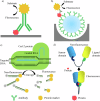Optical biosensors for diagnosing neurodegenerative diseases
- PMID: 40322247
- PMCID: PMC12048351
- DOI: 10.1038/s44328-025-00040-3
Optical biosensors for diagnosing neurodegenerative diseases
Abstract
Neurodegenerative diseases involve the progressive loss of neurons in the brain and nervous system, leading to functional decline. Early detection is critical for improving outcomes and advancing therapies. Optical biosensors, some of which offer rapid, label-free, and ultra-sensitive detection, have been applied to early diagnosis and drug screening. This review examines the principles and performance of different optical biosensors used for diagnosing neurodegenerative diseases and discusses potential future advancements.
Keywords: Diagnostic markers; Imaging and sensing; Neurological disorders.
© The Author(s) 2025.
Conflict of interest statement
Competing interestsJ.S. owns a financial stake in Femtorays Technologies, which develops label-free molecular sensors. All other authors declare no competing interests.
Figures





Similar articles
-
Toward Early Diagnosis of Colorectal Cancer: Focus on Optical Nano Biosensors.Mini Rev Med Chem. 2023;23(9):1033-1049. doi: 10.2174/1389557522666220512142842. Mini Rev Med Chem. 2023. PMID: 35549882 Review.
-
Recent advancements in optical biosensors for cancer detection.Biosens Bioelectron. 2022 Feb 1;197:113805. doi: 10.1016/j.bios.2021.113805. Epub 2021 Nov 15. Biosens Bioelectron. 2022. PMID: 34801795 Review.
-
Progress of new label-free techniques for biosensors: a review.Crit Rev Biotechnol. 2016;36(3):465-81. doi: 10.3109/07388551.2014.991270. Epub 2015 Jan 22. Crit Rev Biotechnol. 2016. PMID: 25608959 Review.
-
Label-Free Optical Resonator-Based Biosensors.Sensors (Basel). 2020 Oct 19;20(20):5901. doi: 10.3390/s20205901. Sensors (Basel). 2020. PMID: 33086566 Free PMC article. Review.
-
A comprehensive review of transduction methods of lectin-based biosensors in biomedical applications.Heliyon. 2024 Sep 24;10(19):e38371. doi: 10.1016/j.heliyon.2024.e38371. eCollection 2024 Oct 15. Heliyon. 2024. PMID: 39386779 Free PMC article. Review.
Cited by
-
Plasmonic ELISA for Biomarker Detection: A Review of Mechanisms, Functionalization Strategies, and Emerging Modalities.ACS Appl Bio Mater. 2025 Jul 21;8(7):5512-5531. doi: 10.1021/acsabm.5c00738. Epub 2025 Jun 17. ACS Appl Bio Mater. 2025. PMID: 40525845 Free PMC article. Review.
References
-
- Staff, C. on L. S. Opportunities in Biology (National Academies Press, Washington, 1988).
Publication types
LinkOut - more resources
Full Text Sources
